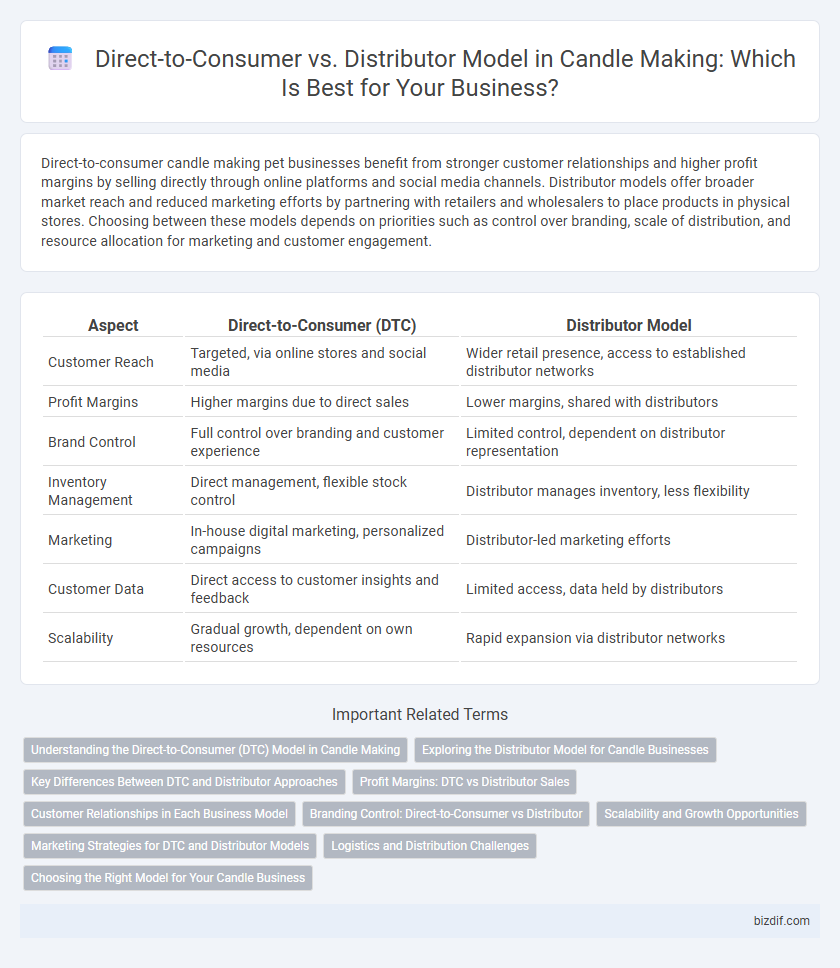Direct-to-consumer candle making pet businesses benefit from stronger customer relationships and higher profit margins by selling directly through online platforms and social media channels. Distributor models offer broader market reach and reduced marketing efforts by partnering with retailers and wholesalers to place products in physical stores. Choosing between these models depends on priorities such as control over branding, scale of distribution, and resource allocation for marketing and customer engagement.
Table of Comparison
| Aspect | Direct-to-Consumer (DTC) | Distributor Model |
|---|---|---|
| Customer Reach | Targeted, via online stores and social media | Wider retail presence, access to established distributor networks |
| Profit Margins | Higher margins due to direct sales | Lower margins, shared with distributors |
| Brand Control | Full control over branding and customer experience | Limited control, dependent on distributor representation |
| Inventory Management | Direct management, flexible stock control | Distributor manages inventory, less flexibility |
| Marketing | In-house digital marketing, personalized campaigns | Distributor-led marketing efforts |
| Customer Data | Direct access to customer insights and feedback | Limited access, data held by distributors |
| Scalability | Gradual growth, dependent on own resources | Rapid expansion via distributor networks |
Understanding the Direct-to-Consumer (DTC) Model in Candle Making
The Direct-to-Consumer (DTC) model in candle making enables artisans to sell handmade candles directly to customers through online platforms and pop-up shops, eliminating intermediaries to maximize profit margins. This approach allows for personalized customer engagement, tailored marketing strategies, and immediate feedback, fostering strong brand loyalty and agility in product development. Leveraging social media and e-commerce tools, candle makers can efficiently scale their business while maintaining control over quality and customer experience.
Exploring the Distributor Model for Candle Businesses
The distributor model in candle making enables businesses to scale by leveraging established retail networks and reducing the complexities of direct customer acquisition. Distributors manage logistics, inventory, and marketing, allowing candle makers to focus on product innovation and quality. This approach often leads to wider market reach and consistent revenue streams compared to a direct-to-consumer strategy.
Key Differences Between DTC and Distributor Approaches
The Direct-to-Consumer (DTC) model in candle making offers greater control over branding, pricing, and customer engagement, enabling personalized marketing strategies and direct feedback loops. In contrast, the distributor model relies on intermediaries to reach broader retail markets, which can increase product exposure but often reduces profit margins and limits direct customer interaction. Choosing between these approaches depends on priorities such as scale, brand control, and investment in customer relationships.
Profit Margins: DTC vs Distributor Sales
Direct-to-consumer (DTC) candle sales typically yield higher profit margins due to the elimination of intermediary fees and increased control over retail pricing. Distributor sales often involve wholesale pricing and commissions, significantly reducing overall revenue per unit sold. Choosing the optimal sales model depends on balancing margin maximization with market reach and operational capacity.
Customer Relationships in Each Business Model
Direct-to-consumer candle makers cultivate intimate customer relationships by offering personalized experiences, direct feedback loops, and tailored product recommendations, enhancing brand loyalty and repeat purchases. Distributor models prioritize broad market reach through retailers but often sacrifice direct interaction with end consumers, limiting opportunities for personalized engagement and immediate feedback. Strong customer connections in the direct-to-consumer model drive higher lifetime value, while distributor models rely on retailer partnerships to scale distribution efficiently.
Branding Control: Direct-to-Consumer vs Distributor
Direct-to-consumer candle makers maintain full branding control, ensuring consistent messaging, product presentation, and customer experience that align with their unique brand identity. In contrast, distributor models often dilute branding due to third-party control over retail environments and marketing materials, potentially creating inconsistency in brand perception. Maintaining direct customer relationships allows candle artisans to gather valuable feedback and tailor brand narratives more effectively than relying on distributors.
Scalability and Growth Opportunities
Direct-to-consumer candle making enables higher profit margins and direct customer insights, fostering scalable personalized marketing strategies and rapid brand growth. Distributor models offer wider market reach and reduced logistical burdens, but typically involve lower margins and less control over customer data, potentially limiting scalability. Focusing on e-commerce and social media integration in the direct-to-consumer approach maximizes growth opportunities by building strong customer loyalty and adapting swiftly to market trends.
Marketing Strategies for DTC and Distributor Models
Direct-to-Consumer (DTC) candle brands leverage personalized digital marketing strategies, including social media advertising, influencer partnerships, and email campaigns, to build strong customer relationships and gather valuable feedback. Distributor models emphasize broad market reach through retail partnerships, trade shows, and wholesale pricing strategies to penetrate diverse retail channels and boost brand visibility. Effective marketing in candle making requires aligning messaging with consumer preferences and optimizing supply chains for timely delivery.
Logistics and Distribution Challenges
Direct-to-consumer candle brands face complex logistics challenges including inventory management, shipping costs, and packaging requirements to ensure safe delivery. Distributor models streamline distribution by leveraging existing networks but often reduce control over branding and increase time to market. Efficient supply chain coordination and demand forecasting are critical in both models to minimize delays and maintain product quality.
Choosing the Right Model for Your Candle Business
Selecting the ideal business model for your candle enterprise involves weighing the benefits of direct-to-consumer sales, which offer higher profit margins and direct customer engagement, against the distributor model that provides broader market reach and reduced marketing efforts. Direct sales enable complete control over branding and customer experience, crucial for niche or artisanal candles emphasizing quality and personalization. Evaluating target audience preferences, production capacity, and marketing resources ensures the chosen model aligns with your growth objectives and operational capabilities.
Direct-to-Consumer vs Distributor Model Infographic

 bizdif.com
bizdif.com